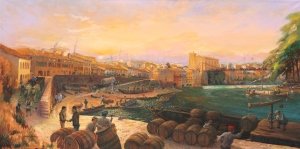To review the fabulous paintings in this collection follow Gaillac Collection.
About the Gaillac district, remote, almost secretive, independant, certainly seductive, was famed for its independent winegrowers was famous long centuries before Bordeaux.
For more about what makes Gaillac special even among special places, read on and enjoy.
Gaillac, (pronounced Guy’ack) at the heart of L’Occitane region, is by French standards a small wine region, yet rich with surprises.
*Introduction
*About Gaillac
*The paintings and prospects
Gordon Frickers, has been visiting Gaillac since 1989 and lived near Gaillac for 8 years, gradually becoming aware of what makes this remote wine region so special and why it has such potential.
Many questions emerged, in particular, how was it wines prized as among the very best by Kings of England & all Northern Europe, prized by the founding fathers of the United States of America, fell into obscurity during the 19 th century?
T: + 44 (0)1865 52 2435 Mobile 00 33 (0) 6 10 66 19 26
or Skype ‘gordonfrickers’
Email: artistfrickers at gmail.com
Simply, securely; to place a deposit or payment on our Payment page to make this or a similar painting.
In turn Gordon’s voyage and painting in the Tarn lead to an idea by Joelle Bault which lead to an invitation from the municipal of Gaillac to paint something of the town and some of the region’s more unusual chateau and domains.
This warmly colourful Gaillac Collection introduces through the eyes of an painter, a remote, beautiful region, for most of each year basking in a benign stable climate reliably producing fabulous wines for you to discover, some now among the finest of France.
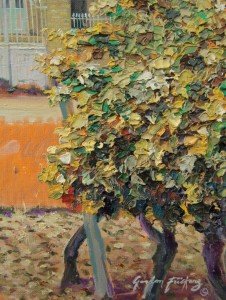
Here is a wine region with a very long history, formally THE preferred wines of South West France.
Gaillac wines: probably no other region can offer you such a diverse selection of fine and table wines within so small a terroir; from the latest bio, in these selections you can discover ancient methods including the Perlé semi sparkling wines that the monk Dom Pérignon studied at Gaillac before he was transferred, so gave birth to the world famous Champagnes and wines made from a grape variety and by methods the Romans would have known.
Gaillac is a place with a very long and at times an amazing story.
Why Gaillac, why not ‘Tarn’ or ‘Abli’?

Roll back the centuries, stand under the then river walls and on the Quai St Jaques, walk a little of La rue de Navigation…
If you will sense ‘here was a port‘ your senses would be on target.
The town that gives it’s name to this obscure wine region, formally among most famous, a jewel in the crown of France, Gaillac, for well over 22 centuries was the port at the navigable head of the turbulent river Tarn.
Beyond Gaillac the rocky river was until 1820 when it was cleared up to Abli, considered unnavigable.
Add to that there is a tradition among marine navigators that you don’t go ‘to’ a place, you go ‘towards’ thereby not tempting providence; so when asked “where bound“, a navigator heading up the river Tarn to the Tarn province would normally reply “Gaillac“.
Three of the foremost experts generously made time to speak with Gordon.
Bertrand de Viviers (Chief du Partrimone, Alian Sorriano, historian, author and Charles-Octave Compte de Noblet d’Anglure who’s family own the land adjoining the opposite river bank to Gailliac.
They stated, it is known the Phoneticians reached Gaillac, a Gaulish village well sited between two streams by a pool and rapids on the banks of the Tarn.
It’s possible wild vines were cultivated well before the Phoneticians but of that we are not certain.
We are certain the river was for 300 years the frontier between the vast Roman province of Narbonne and the lands of Asterix and Obelix, the Gauls.
Roman potter from nearby Montans has been found as far south as Portugal and North as far as Scotland.
Charles who grew up on the river bank stated the quay and narrow road descending to it opposite the town, part of his family lands, is of Roman origin.
That puts the Roman quay up river of the present weir, so it’s possible the Romans built the first weir, lock and bridge at Gaillac.
For sure river trade continued even during the ‘dark ages’, Gaillac grew, was fortified with walls some of which still stand and is known to have had a wooden bridge, one of which was burnt by marauding troops of the Plantagenet prince, Edward, known in history as “The Black Prince” a curious title as he was not black in skin colour, character or deeds.
By 1863, the quay as shown by “The Port of Gaillac 1863” painting were again a hive of activity.

Over 200 barges were register with the Gaillac Capitanerie Office,boats and barges were build on quai St Jaques, the parts routinely being assembled on the beach below the quai while a whole quarter of the old town was devoted to coopers who could make on average 2 barrels per man per day from the very plentiful nearby oak forests of the Tarn.
Gaillac’s three terrior of vineyards for most of the year bask under a warm bright southern sun. Gordon Frickers has been visiting Gaillac since 1989 and lived near Gaillac for 8 years.
isolated for long centuries, today offers us some of the most surprising, most original wines in all France.
In the past 20 years, Gaillac wines have improved dramatically, beginning to recover their former status, even become fashionable among young Londoners seeking something individual, something their parents don’t drink!
The wines of Gaillac have begun to recover those distinctive yet imminently palatable flavours that made the Bordeaux merchants so envious that discriminatory laws were passed forbidding the sale of Gaillac wine from the quays of Bordeaux before the Bordeaux wines were sold.
This “Gaillac Collection” has never been shown except here on the Internet, outside of Gaillac.
Imagine, an exhibition, the paintings as the core, presented with products of the region, wines, foods, other, and live music; who could refuse such an invitation?
An opportunity for a sponsor, imagine, paintings, products of the region, music, costumes, dance, in major cities, London, Paris, New York?
Today this region of the Tarn province, blessed with a varied ever changing countryside and benevolent climate is well connected by both rail and autoroute from Toulouse.
Although in recent years, since near by Albi became a UNESCO listed world heritage town, numbers of visitors have increased yet still most miss the old quarter of Gaillac, many over look altogether, this gem of a town, little realising, in 2016 the town and region were voted by the readers of ‘Connexion’,as having the best quality of life in France.
As a town, a lingering visit will repay you richly, the shopping, the restaurants and cafes, the old quarters, the parks and museums and naturally, the very varied wines.
To further tempt you there is the business of following the wine trails, scaling the Bastides and naturally, the many pleasures of a beautiful varied landscape.
In the past 20 years, Gaillac wines have improved dramatically, beginning to recover their former status, even become fashionable among young Londoners seeking something individual, something their parents don’t drink!
The diminutive region of Gaillac, today offers us some of the most palatable, most original wines in all France.
The Gaillac exhibition is held by the www.ville-gaillac.fr/culture/saison-culturelle
Service Culture de la ville de Gaillac. 80 place d’Hautpoul. 05 63 81 20 19 • culture Gaillac
1 st to 30 December.
a tour via the les chemins de la vigne de Gaillac, the roads of the vines of Gaillac; enjoy.
This series of paintings, many completed, unusually, on location, were a special challenge, a rare opportunity for any artist so “had to be done“.
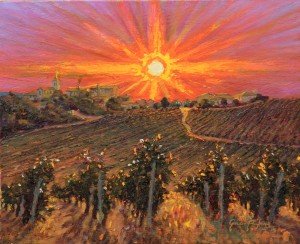
Here seen through the eyes and poetry of a painter, Gaillac’s three terrior of vineyards for most of the year bask under a warm bright southern sun.
Gaillac wines with a history that stretches back at least 2,300 years are rediscovering their past glory, they invite your discovery, meanwhile they have become fashionable, chic, with a new young generation in London.
Among Gaillac wines you can find the latest thinking in bio, sparkling wines that claim they gave birth to the Champagnes and wines made from a grape variety and by methods the Romans would have known.
T: + 44 (0)1865 52 2435 Mobile 00 33 (0) 6 10 66 19 26
or Skype ‘gordonfrickers’
Email: artistfrickers at gmail.com
Simply, securely; to place a deposit or payment on our Payment page to make this or a similar painting.
Wine Art News
During the first half of 2016, 12 new paintings were produced on this subject, 3 of the old town of Gaillac and 9 of a selection of the unusual, interesting chateaux, domains and mas.
I returned to the region for much of the summer and autumn in part to check and paint on the locations, making this collection, I hope you will agree, very special.
The inspiration was my good friend Joelle Bault, and a request from the municipal to create an exhibition for December 2016.
The Gaillac exhibition was held by the www.ville-gaillac.fr/culture/saison-culturelle
Service Culture de la ville de Gaillac. 80 place d’Hautpoul. 05 63 81 20 19 • culture Gaillac
1 st to 30 December.
Today the wines of Gaillac being revitalizing, redeveloping the original qualities that made Gaillac wines sought after long before anyone had heard of Bordeaux.
Can we with the aid of this collection, help this region regain it’s former luster and glory? There is a project with team potential.
Contact me to discuss this.
Maybe YOU or some one you know can help promote this fun, fascinating and profitable project?
The wines or rather their barrels have traditionally been branded to distinguish them from Bordeaux wines because some naughty Bordeaux agents were selling Gaillac wine as Bordeaux.
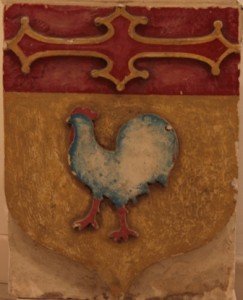
The brand mark chosen is also a French National symbol, a cockerel thus the wines are know both as the harder to pronounce ‘Gaillac’ and by the easily remembered title as ‘Vin De Coq‘.
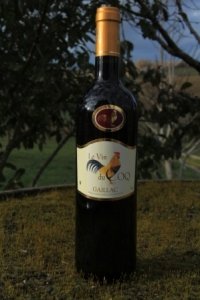
To this day some bottles also sport the cockerel.
This beautiful and productive region has for long centuries been isolated, its trade conducted mostly on the capricious river Tarn to Toulouse and Bordeaux.
Gaillac and Albi remain on a pilgrims route, aside form which few other folk visited.

Gaillac Wine’s Growth Potential.
Why is it that Gaillac, which had such a wine glory, somehow completely lost it?
How was it that the wines prized by Kings of England, in Holland and all Northern Europe had fallen into near complete obscurity during the 20 th century?
Parts of the answer: the inland remoteness of Gaillac, it’s transport served mostly by the capricious, dangerous river Tarn, and later by the railways.
Part of the responsibility is with the restrictions imposed giving priority to Bordeaux, and duties imposed at Bordeaux the principal port of shipment.
Then in the 19 th century there was the quasi-mortal shock of phylloxera.
A devastating disease that arrived in France from North America causing a sort of hysteria among the growers, a disease that was worse that devastation among the vines; very, very few ‘old’ varieties survived.
Then there are problems compounded by the planting of replacements, ‘popular’ vines many of which produce good wines but don’t always reflect the original character of the ‘old’ vines and wines of Gaillac.
In the words of the great authority M.Robert Plageoles of domains des Tres Cantous: ““Gaillac is one of the oldest vignobles of Gaul. No vignobles was chosen by hazard.
Particularly Gaillac; intelligent men saw that Gaillac combined two climates, the humidity of the Bordelais with the heat of the Mediterranean”.
”When a crepage (variety of grape) has been used for five hundred years it can be considered a crepage of Gaillac”.
“Everything else is not a crepage of Gaillac”. His opinion…
Further reading: Le Vin de Gaillac, 2000 ans d’histoire Relié – mars 2001
de Fernand Cousteaux (Auteur), Robert Plageoles (Auteur)
To tour the Gaillac region, meet the people and sample the wines is an amazing voyage of discovery.
T: + 44 (0)1865 52 2435 Mobile 00 33 (0) 6 10 66 19 26
or Skype ‘gordonfrickers’
Email: artistfrickers at gmail.com
Simply, securely; to place a deposit or payment on our Payment page to make this or a similar painting.
The vineyards of Gaillac trace their origins back beyond the days of Rome to Phoenician colonists, brave navigators who risked the hazardous river Tarn to it’s navigable head.
If you know the river Tarn you will appreciate that must have been a considerable adventure, to plant the first known vines and found the village that was to become Gaillac.
The is Tarn the second fastest flowing and one of the most dangerous rivers in Europe.
Gaillac, and nearby Albi, (a town with UNESCO World Hertitage status) nestle in the valley of the river Tarn, a substantial and at times spectacular river, for 300 years the northern border of the Roman province of Narbonne with Gaul.
The river Tarn has given its name to this province, numbered 81 in France.
Gaillac wines are remarkably varied, the surprises don’t stop with the ancient title Vins du Coq; a title that was litterally branded onto the barrels to stop them being sold as bordeaux..
Would you like to experience wines the Romans may have tasted, wines that gave birth to Champagne (Dom Pérignon studied and worked in Gaillac before moving to Champagne) and make other extra ordinary discoveries, the (méthode ancienne, méthode traditionnel, méthode moderne) ?
Gaillac wines are documented at The Tower of London since at least the days of King Henry II who is recorded as wanting more.
Today (2016) in London there has been a revival of interest, Gaillac wines have become a fashionable alternative to better known names like Beaujolais and Bordeaux, they are being discovered by a new young generation.
There are various reasons.
I will tell you more, we CAN enlarge the series, more about Gaillac’s surprising wines, history and the paintings all in related texts as this entry is enlarged.
Stand by to enjoy.
You can learn more by visiting Appellation Gaillac Contrôlée
Gaillac is or rather was at the navigable head of the capricious river Tarn, hence the name of this region, navigators would say, ‘I’m bound for Gaillac’; and there by hangs many a good yarn.
You can commission or acquire simply by contacting us, or purchase these paintings via our ‘Payments‘ page using Paypal or bank to bank;(we can advise and help with the wines too).
By arrangement payments can be in installments.
You could commission a painting like this
Contact US ~ T:+ 44 (0)1865 52 2435 or Skype ‘gordonfrickers’
whatsapp, or phone M: + 33 (0)6 10 66 19 26
Email ~ Important ! please substitute ‘@’ for ‘at’: artistfrickersatgmail.com
Best value, buy from a dedicated artist- buy from a reputable, established artist direct from his studio.
How much in my currency? Try our free XE Currency converter.
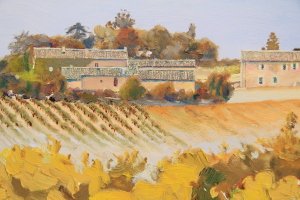
Copyright fees and our Terms are among the most generous on the Internet, don’t hesitate to ask for details by email, whatsapp, or phone+ 44 (0)1865 52 2435 M: + 33 (0)6 10 66 19 26
Gordon Frickers © 20.02.15, updated 06.07.2017, 06.10.2017, 22.05.2018


